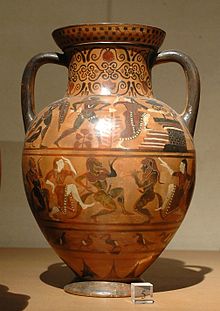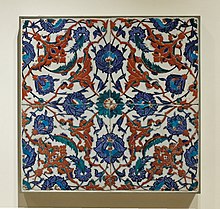
Back فن خزفي Arabic Keramika sənəti Azerbaijani মৃৎশিল্প (শিল্পকলা) Bengali/Bangla Κεραμική Greek هنر سرامیک Persian Céramique d'art French मृत्तिका कला Hindi Seni keramik ID 陶芸 Japanese Keramika (menas) Lithuanian




Ceramic art is art made from ceramic materials, including clay. It may take varied forms, including artistic pottery, including tableware, tiles, figurines and other sculpture. As one of the plastic arts, ceramic art is a visual art. While some ceramics are considered fine art, such as pottery or sculpture, most are considered to be decorative, industrial or applied art objects. Ceramic art can be created by one person or by a group, in a pottery or a ceramic factory with a group designing and manufacturing the artware.[1]
In Britain and the United States, modern ceramics as an art took its inspiration in the early twentieth century from the Arts and Crafts movement, leading to the revival of pottery considered as a specifically modern craft. Such crafts emphasized traditional non-industrial production techniques, faithfulness to the material, the skills of the individual maker, attention to utility, and an absence of excessive decoration that was typical to the Victorian era.[2]
The word "ceramics" comes from the Greek keramikos (κεραμεικός), meaning "pottery", which in turn comes from keramos (κέραμος) meaning "potter's clay".[3] Most traditional ceramic products were made from clay (or clay mixed with other materials), shaped and subjected to heat, and tableware and decorative ceramics are generally still made this way. In modern ceramic engineering usage, ceramics is the art and science of making objects from inorganic, non-metallic materials by the action of heat. It excludes glass and mosaic made from glass tesserae.
There is a long history of ceramic art in almost all developed cultures, and often ceramic objects are all the artistic evidence left from vanished cultures, like that of the Nok in Africa over 2,000 years ago. Cultures especially noted for ceramics include the Chinese, Cretan, Greek, Persian, Mayan, Japanese, and Korean cultures, as well as the modern Western cultures.
Elements of ceramic art, upon which different degrees of emphasis have been placed at different times, are the shape of the object, its decoration by painting, carving and other methods, and the glazing found on most ceramics.
- ^ "Art Pottery Manufacturers and Collectors". Archived from the original on 2 June 2008. Retrieved 5 January 2003.
- ^ "California Art Pottery, 1895-1920" Scholar Works, California State University
- ^ The Webster Encyclopedic Dictionary